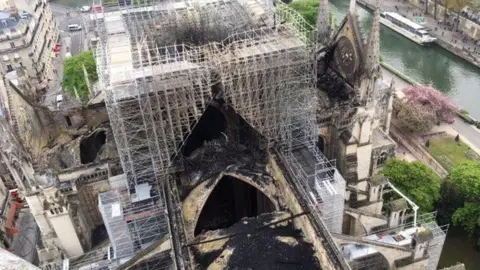Notre-Dame fire: Lead test call for pregnant women and children
 Getty Images
Getty ImagesPregnant women and children living near the fire-ravaged Notre-Dame cathedral have been advised to take blood tests over fears of lead contamination.
The warning has been issued after tests showed a child from the Île de la Cité area of Paris had been exposed to lead.
Health authorities said lead levels in the child's blood exceeded regulatory limits.
Officials say that blaze that destroyed the cathedral on April 15 released toxic substances.
Some 300 tonnes of lead from the cathedral's roof and steeple had melted in the blaze, risking contamination to surrounding areas, according to the French environmental campaign group, Robin des Bois.
A week after the fire, Paris police said the threat from lead exposure was "very localised", but warned people living near the landmark to use "wet wipes to eliminate any dust".
Now the Regional Health Agency in Paris has launched an "environmental investigation" after the child tested positive for lead in a blood test.
The test contained more than 50 micrograms per litre of lead, the agency said.
As a result, children under seven and pregnant women who live on the Île de la Cité - the island area where Notre-Dame was built - have been urged to consult their doctor "as a precaution".
Investigators are seeking to establish the cause of the child's exposure, adding that "other factors" aside from lead released by the fire are not being ruled out.
Lead, a metal which is toxic to humans, affects multiple body systems and is particularly harmful to young children, according to the World Health Organization (WHO).
It can cause neurological defects, as well as nervous system and kidney problems, and there is no known level of exposure that is considered safe, the WHO says.
Robin des Bois has urged officials to "decontaminate" the site before carrying out any reconstruction work.
It said in April that the cathedral had been "reduced to the state of toxic waste", urging authorities to detoxify the tonnes of rubble, ash and wastewater produced in the disaster.
There were fears the 800-year-old cathedral could be completely destroyed during the fierce blaze in April.
Firefighters managed to save the structure and much of its interior - but emergency work has been taking place since to stabilise the building.
French President Emmanuel Macron has vowed to rebuild the symbol of Paris within five years - in time for the Olympics in the city scheduled for 2024.
